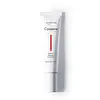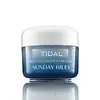What's inside
What's inside
 Key Ingredients
Key Ingredients

 Benefits
Benefits

 Concerns
Concerns

 Ingredients Side-by-side
Ingredients Side-by-side

Water
Skin ConditioningParaffinum Liquidum
EmollientCysteamine Hcl
AntioxidantNiacinamide
SmoothingButyrospermum Parkii Butter
Skin ConditioningGlyceryl Stearate
EmollientLecithin
EmollientIsopropyl Myristate
EmollientCetyl Alcohol
EmollientCeteareth-20
CleansingAscorbyl Palmitate
AntioxidantSodium Ascorbyl Phosphate
AntioxidantOctyldodecanol
EmollientPhenoxyethanol
PreservativeEthylhexylglycerin
Skin ConditioningPropylheptyl Caprylate
EmollientCeteareth-12
EmulsifyingCetearyl Alcohol
EmollientCetyl Palmitate
EmollientParfum
MaskingXanthan Gum
EmulsifyingPEG-30 Dipolyhydroxystearate
EmulsifyingTocopherol
AntioxidantBeeswax
Emulsion StabilisingBHT
AntioxidantTetrasodium EDTA
Hexyl Cinnamal
PerfumingLinalool
PerfumingGeraniol
PerfumingWater, Paraffinum Liquidum, Cysteamine Hcl, Niacinamide, Butyrospermum Parkii Butter, Glyceryl Stearate, Lecithin, Isopropyl Myristate, Cetyl Alcohol, Ceteareth-20, Ascorbyl Palmitate, Sodium Ascorbyl Phosphate, Octyldodecanol, Phenoxyethanol, Ethylhexylglycerin, Propylheptyl Caprylate, Ceteareth-12, Cetearyl Alcohol, Cetyl Palmitate, Parfum, Xanthan Gum, PEG-30 Dipolyhydroxystearate, Tocopherol, Beeswax, BHT, Tetrasodium EDTA, Hexyl Cinnamal, Linalool, Geraniol
Water
Skin ConditioningPropanediol
SolventGlycerin
HumectantCaprylic/Capric Triglyceride
MaskingEthyl Macadamiate
Skin ConditioningHydrolyzed Jojoba Esters
Skin ConditioningDicaprylyl Carbonate
EmollientIsododecane
EmollientSodium Acrylates Copolymer
Alpha-Arbutin
AntioxidantPhenoxyethanol
PreservativeCucumis Sativus Extract
Skin ConditioningPentylene Glycol
Skin ConditioningAdipic Acid/Neopentyl Glycol Crosspolymer
Lauryl Dimethicone
Skin ConditioningHydrogenated Polyisobutene
EmollientAllantoin
Skin ConditioningTetrasodium EDTA
Strelitzia Nicolai Seed Aril Extract
Skin ConditioningTamarindus Indica Seed Gum
Emulsion StabilisingAesculus Hippocastanum Seed Extract
Skin ConditioningSodium Hyaluronate Crosspolymer
HumectantSodium Hyaluronate
HumectantPapain
Skin ConditioningCarbomer
Emulsion Stabilising1,2-Hexanediol
Skin ConditioningAlgin
MaskingCaprylyl Glycol
EmollientLecithin
EmollientMelia Azadirachta Leaf Extract
Skin ConditioningMelia Azadirachta Flower Extract
Skin ConditioningCoccinia Indica Fruit Extract
Skin ConditioningSolanum Melongena Fruit Extract
Skin ConditioningAloe Barbadensis Flower Extract
EmollientOcimum Sanctum Leaf Extract
Skin ConditioningOcimum Basilicum Flower/Leaf Extract
TonicCurcuma Longa Root Extract
MaskingCorallina Officinalis Extract
Skin ConditioningEthylhexylglycerin
Skin ConditioningSodium Benzoate
MaskingPotassium Benzoate
PreservativeChlorphenesin
AntimicrobialTocopherol
AntioxidantMalic Acid
BufferingSynthetic Fluorphlogopite
Titanium Dioxide
Cosmetic ColorantTin Oxide
AbrasiveWater, Propanediol, Glycerin, Caprylic/Capric Triglyceride, Ethyl Macadamiate, Hydrolyzed Jojoba Esters, Dicaprylyl Carbonate, Isododecane, Sodium Acrylates Copolymer, Alpha-Arbutin, Phenoxyethanol, Cucumis Sativus Extract, Pentylene Glycol, Adipic Acid/Neopentyl Glycol Crosspolymer, Lauryl Dimethicone, Hydrogenated Polyisobutene, Allantoin, Tetrasodium EDTA, Strelitzia Nicolai Seed Aril Extract, Tamarindus Indica Seed Gum, Aesculus Hippocastanum Seed Extract, Sodium Hyaluronate Crosspolymer, Sodium Hyaluronate, Papain, Carbomer, 1,2-Hexanediol, Algin, Caprylyl Glycol, Lecithin, Melia Azadirachta Leaf Extract, Melia Azadirachta Flower Extract, Coccinia Indica Fruit Extract, Solanum Melongena Fruit Extract, Aloe Barbadensis Flower Extract, Ocimum Sanctum Leaf Extract, Ocimum Basilicum Flower/Leaf Extract, Curcuma Longa Root Extract, Corallina Officinalis Extract, Ethylhexylglycerin, Sodium Benzoate, Potassium Benzoate, Chlorphenesin, Tocopherol, Malic Acid, Synthetic Fluorphlogopite, Titanium Dioxide, Tin Oxide
Ingredients Explained
These ingredients are found in both products.
Ingredients higher up in an ingredient list are typically present in a larger amount.
Ethylhexylglycerin (we can't pronounce this either) is commonly used as a preservative and skin softener. It is derived from glyceryl.
You might see Ethylhexylglycerin often paired with other preservatives such as phenoxyethanol. Ethylhexylglycerin has been found to increase the effectiveness of these other preservatives.
Lecithin is a term for a group of substances found in the cell membranes of plants, animals, and humans. They are made up of mixture of phospholipids.
This ingredient has emollient and emulsifying properties.
As an emollient, lecithen helps soften the skin and creates a barrier to keep moisture in.
As an emulsifier, it also helps prevent water and oil ingredients from separating. Lecithin can also help ingredients be better absorbed by the skin.
This is because the phospholipids in lecithin produce liposomes. Liposomes help other ingredients get through the skin barrier.
Depending on the source of this ingredient, lecithin may not be fungal acne safe. This is because some sources of lecithin come from soybean oil, which may feed the malassezia yeast that feeds fungal acne.
We recommend reaching out to the brand you are purchasing from to inquire about the source of their lecithin.
Some other names for this ingredient include soy lecithin and deoiled soy lecithin.
Learn more about LecithinPhenoxyethanol is a preservative that has germicide, antimicrobial, and aromatic properties. Studies show that phenoxyethanol can prevent microbial growth. By itself, it has a scent that is similar to that of a rose.
It's often used in formulations along with Caprylyl Glycol to preserve the shelf life of products.
Tetrasodium EDTA is the salt formed from neutralizing ethylenediamine tetraacetic acid with sodium hydroxide. It is a chelating agent and used to prevent metal ions from binding to other ingredients. This helps keep the product and ingredients stable.
Tetrasodium EDTA comes as a white solid and is soluble in water.
Tocopherol (also known as Vitamin E) is a common antioxidant used to help protect the skin from free-radicals and strengthen the skin barrier. It's also fat soluble - this means our skin is great at absorbing it.
Vitamin E also helps keep your natural skin lipids healthy. Your lipid skin barrier naturally consists of lipids, ceramides, and fatty acids. Vitamin E offers extra protection for your skin’s lipid barrier, keeping your skin healthy and nourished.
Another benefit is a bit of UV protection. Vitamin E helps reduce the damage caused by UVB rays. (It should not replace your sunscreen). Combining it with Vitamin C can decrease sunburned cells and hyperpigmentation after UV exposure.
You might have noticed Vitamin E + C often paired together. This is because it is great at stabilizing Vitamin C. Using the two together helps increase the effectiveness of both ingredients.
There are often claims that Vitamin E can reduce/prevent scarring, but these claims haven't been confirmed by scientific research.
Learn more about TocopherolWater. It's the most common cosmetic ingredient of all. You'll usually see it at the top of ingredient lists, meaning that it makes up the largest part of the product.
So why is it so popular? Water most often acts as a solvent - this means that it helps dissolve other ingredients into the formulation.
You'll also recognize water as that liquid we all need to stay alive. If you see this, drink a glass of water. Stay hydrated!
Learn more about Water